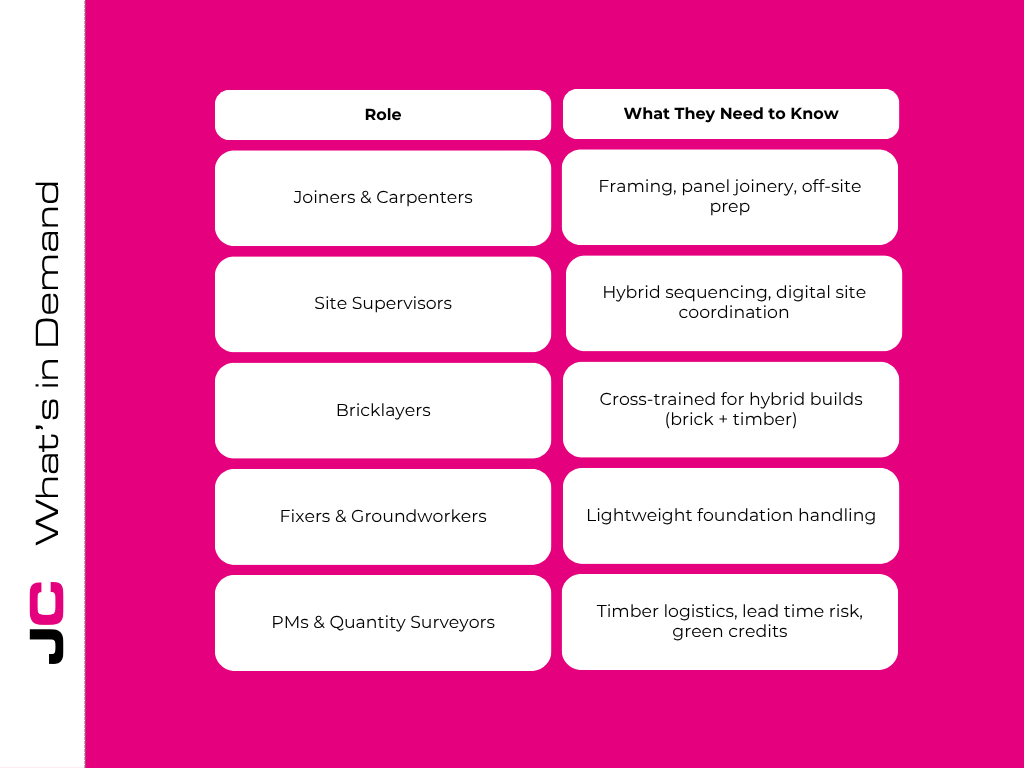From Brick to Timber: What the Shift in Materials Means for Your Workforce
From Brick to Timber: What the Shift in Materials Means for Your Workforce
Summary
Timber’s not a trend; it’s a response to a broken system. Brick shortages, carbon pressure, and the need to build faster have forced contractors to adapt, whether they’re ready or not. In this blog, Jamie Trevett unpacks what’s driving the shift across the UK and US, the real implications for recruitment, and why ignoring it could cost your firm the jobs you're bidding for in 2025.
UK: Brick Has Hit a Wall, Literally and Figuratively
Let’s not sugarcoat it.
The UK’s brick supply chain is buckling.
Between material delays, a shortage of trained bricklayers, and rising environmental expectations, traditional builds are hitting a wall. According to a report in the FT, housebuilders are pivoting to timber just to keep projects moving.
And it’s not just about speed, it’s about sustainability mandates, planning permissions, and developer preferences.
We’ve spoken to SME contractors across Manchester, Birmingham, and Essex, same story: They’ve got the land. They’ve got the pipeline. But they’re one skillset short of delivering it.
US: Mass Timber Isn’t New Anymore, It’s Here.
In the US, the conversation has already moved on.
Mass timber isn’t emerging. It’s active code in over 20 states. Major cities like Seattle, Denver, and Austin are greenlighting mid-rise and even high-rise timber structures.
And with the Infrastructure Investment and Jobs Act now backing sustainability-driven public builds, guess who’s getting the contracts?
Not firms with the lowest bid.
Firms with the right experience.
But here’s what’s wild, we’re still getting calls from US contractors who say:
“Can you send us someone who’s seen a CLT panel go up before?”
If you’ve got no one on your crew who’s worked with timber, you’re a risk.
And clients aren’t taking risks in this economy.
Timber Changes Everything; Including Who You Hire
Let’s make this clear:
You don’t just swap brick for timber and carry on like normal.
The shift in material means:
- New install sequences.
- Pre-fab coordination.
- Transport handling differences.
- And most importantly, workforce shifts.
Here’s what’s in demand right now (on both sides of the pond):

Recruitment Lag = Project Loss
We’ve had more than a few clients lose bids because they couldn’t prove they had timber-capable staff.
The work’s out there. The appetite’s real.
But if you can’t staff the job with people who’ve done it before, the client moves on.
And no, a crash course the week before doesn’t cut it.
Just Recruit+ Clients Are Getting Ahead of the Curve
Our subscription clients have started building out timber-ready benches already.
They’re not gambling on “maybe we’ll find someone.”
They’re:
- Lining up joiners trained in modular and offsite.
- Recruiting supervisors who’ve worked with panelised systems.
- Asking for resumes with timber project history, not just general site work.
They’re not playing catch-up.
They’re getting the green-light because they’re already staffed to build it.
Final Take: If You Want Timber Contracts, You Need Timber Talent
We can talk about carbon all day.
We can talk about net zero, or planning changes, or BREEAM scores.
But here’s the bottom line:
You can’t build anything, sustainable or otherwise, without the right people on the job.
If timber’s where the market is headed, and you’re still recruiting like it’s 2015, you’re not in the race.







